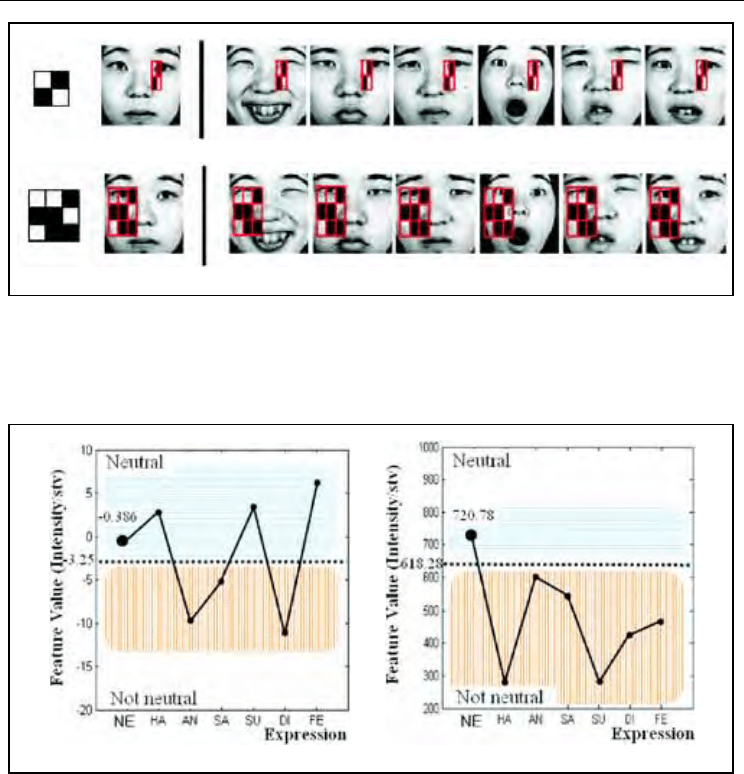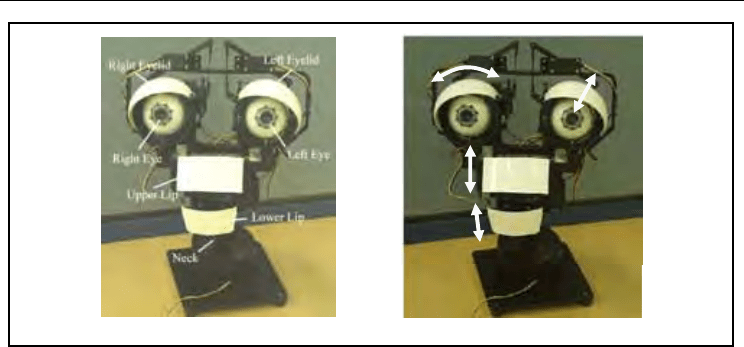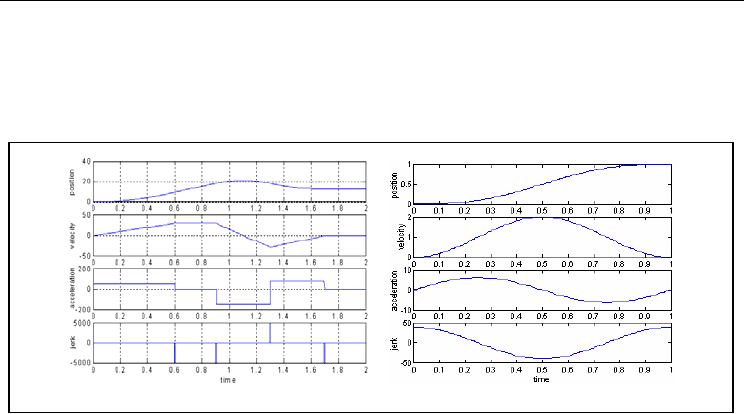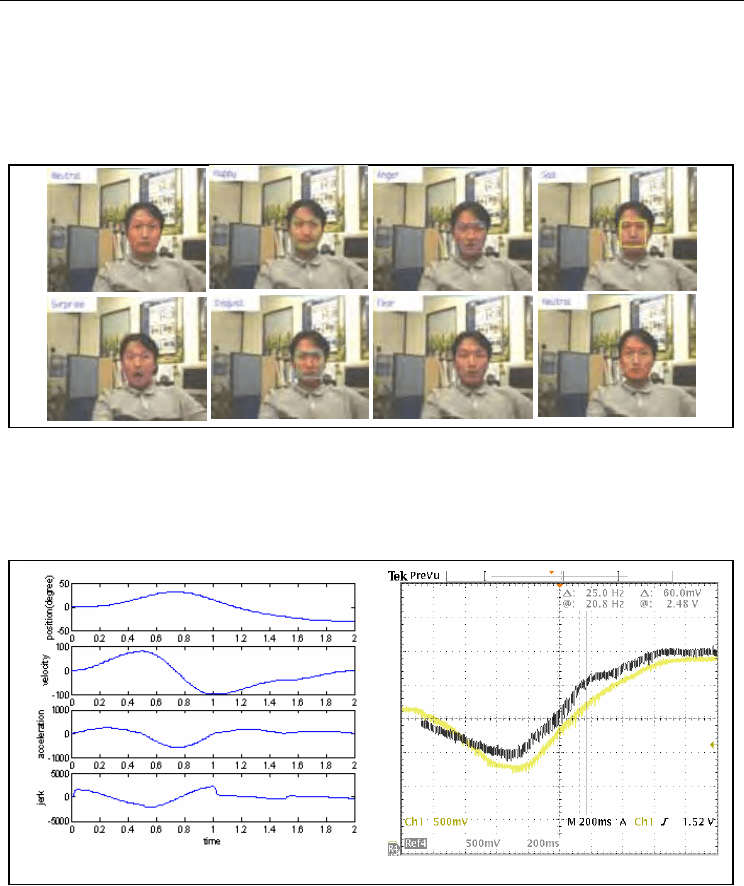Sarkar N. (ed.) Human-Robot Interaction
Подождите немного. Документ загружается.


A Facial Expression Imitation System for the Primitive of Intuitive Human-Robot Interaction 221
(a)
(b)
Figure 6. Applying neutral rectangle features to each facial expression: (a) the selected
feature that distinguishes a neutral facial expression with the least error from other
expressions in using the Viola-Jones features, (b) the selected feature that distinguishes a
neutral facial expression with the least error from other expressions using the proposed
rectangle features
(a) (b)
Figure 7. Comparison of feature values in applying a neutral rectangle feature to each facial
expression: (a) using the Viola-Jones features, (b) using the proposed features
4. Facial Expression Generation
There are several projects that focus on the development of robotic faces. Robotic faces are
currently classified in terms of their appearance; that is, whether they appear real,
mechanical or mascot-like. In brief, this classification is based on the existence and flexibility
of the robot’s skin. The real type of robot has flexible skin, the mechanical type has no skin,
and the mascot type has hard skin. Note that although there are many other valuable robotic
faces in the world, we could not discuss all robots in this paper because space is limited.
In the real type of robot, there are two representative robotic faces: namely, Saya and
Leonardo. Researchers at the Science University of Tokyo developed Saya, which is a

Human-Robot Interaction 222
human-like robotic face. The robotic face, which typically resembles a Japanese woman, has
hair, teeth, silicone skin, and a large number of control points. Each control point is mapped
to a facial action unit (AU) of a human face. The facial AUs characterize how each facial
muscle or combination of facial muscles adjusts the skin and facial features to produce
human expressions and facial movements (Ekman et al., 2001) (Ekman & Friesen, 2003).
With the aid of a camera mounted in the left eyeball, the robotic face can recognize and
produce a predefined set of emotive facial expressions (Hara et al., 2001).
In collaboration with the Stan Winston studio, the researchers of Breazeal’s laboratory at the
Massachusetts Institute of Technology developed the quite realistic robot Leonardo. The
studio's artistry and expertise of creating life-like animalistic characters was used to enhance
socially intelligent robots. Capable of near-human facial expressions, Leonardo has
61 degrees of freedom (DOFs), 32 of which are in the face alone. It also has 61 motors and a
small 16 channel motion control module in an extremely small volume. Moreover, it stands
at about 2.5 feet tall, and is one of the most complex and expressive robots ever built
(Breazeal, 2002).
With respect to the mechanical looking robot, we must consider the following well-
developed robotic faces. Researchers at Takanishi’s laboratory developed a robot called the
W
aseda Eye No.4 or WE-4, which can communicate naturally with humans by expressing
human-like emotions. WE-4 has 59 DOFs, 26 of which are in the face. It also has many
sensors which serve as sensory organs that can detect extrinsic stimuli such as visual,
auditory, cutaneous and olfactory stimuli. WE-4 can also make facial expressions by using
its eyebrows, lips, jaw and facial color. The eyebrows consist of flexible sponges, and each
eyebrow has four DOFs. For the robot’s lips, spindle-shaped springs are used. The lips
change their shape by pulling from four directions, and the robot’s jaw, which has one DOF,
opens and closes the lips. In addition, red and blue electroluminescence sheets are applied
to the cheeks, enabling the robot to express red and pale facial colors (Miwa et al., 2002)
(Miwa et al., 2003).
Before developing Leonardo, Breazeal’s research group at the Massachusetts Institute of
Technology developed an expressive anthropomorphic robot called Kismet, which engages
people in natural and expressive face-to-face interaction. Kismet perceives a variety of
natural social cues from visual and auditory channels, and it delivers social signals to the
human caregiver through gaze direction, facial expression, body posture, and vocal
babbling. With 15 DOFs, the face of the robot displays a wide assortment of facial
expressions which, among other communicative purposes, reflect its emotional state.
Kismet’s ears have 2 DOFs each; as a result, Kismet can perk its ears in an interested fashion
or fold them back in a manner reminiscent of an angry animal. Kismet can also lower each
eyebrow, furrow them in frustration, elevate them for surprise, or slant the inner corner of
the brow upwards for sadness. Each eyelid can be opened and closed independently,
enabling Kismet to wink or blink its eyes. Kismet also has four lip actuators, one at each
corner of the mouth; the lips can therefore be curled upwards for a smile or downwards for
a frown. Finally, Kismet’s jaw has a single DOF (Breazeal, 2002).
The mascot-like robot is represented by a facial robot called Pearl, which was developed at
Carnegie Mellon University. Focused on robotic technology for the elderly, the goal of this
project is to develop robots that can provide a mobile and personal service for elderly
people who suffer from chronic disorders. The robot provides a research platform of social
interaction by using a facial robot. However, because this project is aimed at assisting

A Facial Expression Imitation System for the Primitive of Intuitive Human-Robot Interaction 223
elderly people, the functions of the robot are focused more on mobility and auditory
emotional expressions than on emotive facial expressions.
Figure 8. The whole system architecture. The image processing runs on a personal computer
(PC) with a commercial microprocessor. In addition, the motion controller operates in a
fixed point digital signal processor (DSP). An interface board with a floating point DSP
decodes motor position commands and transfers camera images to the PC
Another mascot-like robot called ICat was developed by Philips. This robot is an
experimentation platform for human-robot interaction research. ICat can generate many
different facial expressions such as happiness, surprise, anger, and sad needed to make the
human-robot interactions social. Unfortunately, there is no deep research of emotion
models, relation between emotion and facial expressions, and emotional space.
4.1 System Description
The system architecture in this study is designed to meet the challenges of real-time visual-
signal processing (nearly 30Hz) and a real-time position control of all actuators (1KHz) with
minimal latencies. Ulkni is the name given to the proposed robot. Its vision system is built
around a 3 GHz commercial PC. Ulkni’s motivational and behavioral systems run on a
TMS320F2812 processor and 12 internal position controllers of commercial RC servos. The
cameras in the eyes are connected to the PC by an IEEE 1394a interface, and all position
commands of the actuators are sent by the RS-232 protocol (see Fig. 8). Ulkni has 12 degrees of
freedom (DOF) to control its gaze direction, two DOF for its neck, four DOF for its eyes, and
six DOF for other expressive facial components, in this case the eyelids and lips (see Fig. 9).
The positions of the proposed robot’s eyes and neck are important for gazing toward a target
of its attention, especially a human face. The control scheme for this robot is based on a
distributed control method owing to RC servos. A commercial RC servo generally has an
internal controller; therefore, the position of a RC servo is easily controlled by feeding a signal
with a proper pulse width to indicate the desired position, and by then letting the internal
controller operate until the current position of the RC servo reaches the desired position.

Human-Robot Interaction 224
f
c
d
e
f
c
d
e
(a) (b)
Figure 9. Ulkni’s mechanisms. The system has 12 degrees of freedom (DOF). The eyes and
the neck can pan and tilt independently. The eyelids also have two DOFs to roll and to
blink. The lips can tilt independently. In Ulkni, rotational movements of the eyelids, c,
display the emotion instead of eyebrows. Ulkni’s eyelids can droop and it can also squint
and close its eyes, d. Ulkni can smile thanks to the curvature of its lips, e and f
Two objectives of the development of this robot in a control sense were to reduce the jerking
motion and to determine the trajectories of the 12 actuators in real time. For this reason, the
use of a high-speed, bell-shaped velocity profile of a position trajectory generator was
incorporated in order to reduce the magnitude of any jerking motion and to control the 12
actuators in real time. Whenever the target position of an actuator changes drastically, the
actuator frequently experiences a severe jerking motion. The jerking motion causes electric
noise in the system’s power source, worsening the system’s controller. It also breaks down
mechanical components. The proposed control method for reducing the jerking motion is
essentially equal to a bell-shaped velocity profile. In developing the bell-shaped velocity
profile, a cosine function was used, as a sinusoidal function is infinitely differentiable. As a
result, the control algorithm ensures that the computation time necessary to control the 12
actuators in real time is achieved.
4.2 Control Scheme
Our control scheme is based on the distributed control method owing to RC servos. A
commercial RC servo generally has an internal controller. Therefore, the position of a RC
servo is easily controlled by feeding the signal that has the proper pulse width, which
indicates a desired position, to the RC servo and then letting the internal controller operate
until the current position of an RC servo reaches the desired position.
As mentioned above, if the target position of an actuator is changed drastically, severe jerking
motion of the actuator will occur frequently. Jerking motions would cause electric noise in the
power source of the system, worsen the controller of the system, and break down mechanical
components. Therefore, our goal is to reduce or eliminate all jerking motion, if possible.
There have been some previous suggestions on how to solve the problems caused by jerking
motion. Lloyd proposed the trajectory generating method, using blend functions (Lloyd &
Hayward, 1991). Bazaz proposed a trajectory generator, based on a low-order spline method

A Facial Expression Imitation System for the Primitive of Intuitive Human-Robot Interaction 225
(Bazaz & Tondu, 1999). Macfarlane proposed a trajectory generating method using an s-
curve acceleration function (Macfarlane & Croft, 2001). Nevertheless, these previous
methods spend a large amount of computation time on calculating an actuator’s trajectory.
Therefore, none of these methods would enable real-time control of our robot, Ulkni, which
has 12 actuators.
(a) (b)
Figure 10. Comparison between the typical velocity control and the proposed bell-shaped
velocity control: (a) trajectories of motor position, velocity, acceleration, and jerking motion
with conventional velocity control, (b) trajectories of those with the proposed bell-shaped
velocity control using a sinusoidal function
The two objectives of our research are to reduce jerking motion and to determine the
trajectories of twelve actuators in real-time. Therefore, we propose a position trajectory
generator using a high-speed, bell-shaped velocity profile, to reduce the magnitude of any
jerking motion and to control twelve actuators in real-time. In this section, we will describe
the method involved in achieving our objectives.
Fast Bell-shaped Velocity Profile
The bigger the magnitude of jerking motion is, the bigger the variation of acceleration is
(Tanaka et al., 1999). Therefore, we can say that reducing the jerking motion is that the
function of acceleration should be differentiable.
Presently, nearly all of the position control methods use a trapezoid velocity profile to
generate position trajectories. Such methods are based on the assumption of uniform
acceleration. Uniform acceleration causes the magnitude of jerking motion to be quite large.
If the function of acceleration is not differentiable in any period of time an almost infinite
magnitude of jerking motion will occur. Therefore, we should generate a velocity profile
with a differentiable acceleration of an actuator (see Fig. 10).
Currently, researchers working with intelligent systems are trying to construct an adequate
analysis of human motion. Human beings can grab and reach objects naturally and
smoothly. Specifically, humans can track and grab an object smoothly even if the object is
moving fast. Some researchers working on the analysis of human motion have begun to
model certain kinds of human motions. In the course of such research, it has been
discovered that the tips of a human’s fingers move with a bell-shaped velocity profile when
a human is trying to grab a moving object (Gutman et al., 1992). A bell-shaped velocity is
generally differentiable. Therefore, the magnitude of jerking motion is not large and the
position of an actuator changes smoothly.

Human-Robot Interaction 226
We denote the time by the variable
t
, the position of an actuator at time
t
by the variable
()
pt
, the velocity of that at time
t
by the variable
()
vt
, the acceleration of that at time
t
by
the variable
()
at
, the goal position by the variable
T
p
, and the time taken to move the
desired position by the variable
T
.
In (5), a previous model which has a bell-shaped velocity profile is shown.
()
()
()
()
()
23
93660
T
ppt
at vt
at
TT T
−
=− − +
(5)
The basic idea of our control method to reduce jerking motion is equal to a bell-shaped
velocity profile. The proposed algorithm is used to achieve the computation time necessary
to control twelve actuators in real-time. Therefore, we import a sinusoidal function because
it is infinitely differentiable. We developed a bell-shaped velocity profile by using a cosine
function. Assuming the normalized period of time is
01t≤≤
, (6) shows the proposed bell-
shaped velocity, the position, the acceleration, and the jerking motion of an actuator (see Fig.
10).
As seen in (6), the acceleration function,
()
at
, is a differentiable, as well as the velocity
function. Therefore, we can obtain a bounded jerk motion function. To implement this
method, the position function,
()
pt
, is used in our system.
()
() ()
()
()
()
1
0
2
1 cos 2
1
sin 2
2
() 2 sin2
4 cos 2
vt t
pt vtdt t t
dv t
at t
dt
da t
at t
dt
π
π
π
ππ
ππ
=−
==−
==
==
³
(6)
,
01where t≤≤
.
Finally, the developed system can be controlled in real-time even though target positions of
12 actuators are frequently changed. Some experimental results will be shown later.
4.3 Basic Function; Face Detection and Tracking
The face detection method is similar to that of Viola and Jones. Adaboost-based face
detection has gained significant attention. It has a low computational cost and is robust to
scale changes. Hence, it is considered as state-of-the-art in the face detection field.
AdaBoost-Based Face Detection
Viola et al. proposed a number of rectangular features for the detection of a human face in
real-time (Viola & Jones, 2001) (Jones & Viola, 2003). These simple and efficient rectangular
features are used here for the real-time initial face detection. Using a small number of
important rectangle features selected and trained by AdaBoost learning algorithm, it was
possible to detect the position, size and view of a face correctly. In this detection method, the
value of rectangle features is calculated by the difference between the sum of intensities

A Facial Expression Imitation System for the Primitive of Intuitive Human-Robot Interaction 227
within the black box and those within the white box. In order to reduce the calculation time
of the feature values, integral images are used here. Finally, the AdaBoost learning
algorithm selects a small set of weak classifiers from a large number of potential features.
Each stage of the boosting process, which selects a new weak classifier, can be viewed as a
feature selection process. The AdaBoost algorithm provides an effective learning algorithm
on generalization performance.
The implemented initial face detection framework of our robot is designed to handle frontal
views (-20~+20 [deg]).
Face Tracking
The face tracking scheme proposed here is a simple successive face detection within a
reduced search window for real-time performance. The search for the new face location in
the current frame starts at the detected location of the face in the previous frame. The size of
the search window is four times bigger than that of the detected face.
4.4 Visual Attention
Gaze direction is a powerful social cue that people use to determine what interests others.
By directing the robot’s gaze to the visual target, the person interacting with the robot can
accurately use the robot’s gaze as an indicator of what the robot is attending to. This greatly
facilitates the interpretation and readability of the robot’s behavior, as the robot reacts
specifically to the thing that it is looking at. In this paper, the focus is on the basic behavior
of the robot - the eye-contact - for human-robot interaction. The head-eye control system
uses the centroid of the face region of the user as the target of interest. The head-eye control
process acts on the data from the attention process to center on the eyes on the face region
within the visual field.
In an active stereo vision system, it is assumed for the purposes of this study that joint
angles,
1n×
∈ș R
, are divided into those for the right camera,
1
1n
r
×
∈ș R
, and those for the
left camera,
2
1n
l
×
∈ș R
, where
1
nn
≤
and
2
nn
≤
. For instance, if the right camera is
mounted on an end-effector which is moving by joints 1, 2, 3, and 4, and the left camera is
mounted on another end-effector which is moving by joints 1, 2, 5, and 6, the duplicated
joints would be joints 1 and 2.
Robot Jacobian describes a velocity relation between joint angles and end-effectors. From
this perspective, it can be said that Ulkni has two end-effectors equipped with two cameras,
respectively. Therefore, the robot Jacobian relations are described as
rrr
=vJș
,
lll
=vJș
for the two end-effectors, where
r
v
and
l
v
are the right and the left end-effector velocities,
respectively. Image Jacobian relations are
rrr
=sLv
and
lll
=sLv
for the right and the left
camera, respectively, where
r
s
and
l
s
are velocity vectors of image features,
r
L
and
l
L
are image Jacobian, and
r
v
and
l
v
may be the right and the left camera velocity if the
cameras are located at the corresponding end-effectors. The image Jacobian is calculated for
each feature point in the right and the left image, as in (7). In (7), Z is rough depth value of
features and (x, y) is a feature position in a normalized image plane.
2
,
2
1/ 0 / (1 )
01/ /1
irl
Z
xZ xy x y
Z
yZ y xy x
=
−−+
=
−+−−
§·
¨¸
©¹
L
(7)

Human-Robot Interaction 228
In order to simplify control of the robotic system, it was assumed that the robot is a pan-tilt
unit with redundant joints. For example, the panning motion of the right (left) camera is
moved by joints 1 and 3(5), and tilt motion by joint 2 and 4(6). The interaction matrix is re-
calculated as follows:
2
2
(1 )
1
,
iiii
xy x
yxy
−+
=
+−
§·
=
¨¸
©¹
LLs ș
(8)
The visual attention task is identical to the task that is the canter of the detected face region
to the image center. The visual attention task can be considered a regulation problem,
ii i
=−=ss0s
. As a result, the joint angles are updated, as follows:
()
()
2
22
2
1
1
1
1
iiiii
i
xy x
xy
x
y
xy
y
y
x
λ
++
−+
==
§·
ªº
=
¨¸
«»
¨¸
++
+
¬¼
©¹
§·
=
¨¸
−
©¹
LLș ss
s
(9)
Two eyes are separately moved with a pan-tilt motion by the simple control law, as shown
in (8). The neck of the robot is also moved by the control law in (9) with a different weight.
5. Experimental Results
5.1 Recognition Rate Comparison
The test database for the recognition rate comparison consists of a total of 407 frontal face
images selected from the AR face database, PICS (The Psychological Image Collection at
Stirling) database and Ekman’s face database. Unlike the trained database, the test database
was selected at random from the above facial image database. Consequently, the database
has not only normal frontal face images, but also slightly rotated face images in plane and
out of plane, faces with eye glasses, and faces with facial hair. Furthermore, whereas the
training database consists of Japanese female face images, the test database is comprised of
all races. As a result, the recognition rate is not sufficiently high because we do not consider
image rotation and other races. However, it can be used to compare the results of the 7
rectangle feature types and those of the 42 rectangle feature types. Fig. 11 shows the
recognition rate for each facial expression and the recognition comparison results of the 7
rectangle feature case and the 42 rectangle feature case using the test database. In Fig. 11,
emotions are indicated in abbreviated form. For example, NE is neutral facial expression
and HA is happy facial expression. As seen in Fig. 11, happy and surprised expressions
show facial features having higher recognition rate than other facial expressions.

A Facial Expression Imitation System for the Primitive of Intuitive Human-Robot Interaction 229
Figure 11. Comparison of the rate of facial expression recognition; ‘+’ line shows the correct
rate of each facial expression in case of 7 (Viola’s) feature types, ‘㧖’ line shows the correct
rate of each facial expression in case of the proposed 42 feature types
In total, the 7 rectangle feature case has a lower recognition rate than the 42 rectangle feature
case. For emotion, the difference ranges from 5% to 10% in the recognition rate. As indicated
by the above results, it is more efficient to use 42 types of rectangle features than 7 rectangle
features when training face images.
5.2 Processing Time Results
(a) (b)
(c) (d)
Figure 12. Facial expression recognition experiment from various facial expressions
Our system uses a Pentium IV, 2.8GHz CPU and obtains 320×240 input images from a
camera. 250~300ms are required for a face to be detected for the case of an input image

Human-Robot Interaction 230
where the face is directed forward. In the process of initial face detection, the system
searches the entire input image area (320×240 pixels) and selects a candidate region and then
performs pattern classification in the candidate region. As such, this takes longer than face
tracking. Once the face is detected, the system searches the face in the tracking window. This
reduces the processing time remarkably. Finally, when the face is detected, the system can
deal with 20~25 image frames per second.
Figure 13. Facial expression recognition results. These photos are captured at frame 0, 30, 60,
90, 120, 150, 180 and 210 respectively (about 20 frames/sec)
5.2 Facial Expression Recognition Experiments
In Fig. 12, the test images are made by merging 6 facial expression images into one image.
(a) (b)
Figure 14. The initial position of an actuator is zero. Three goal positions are commanded at
times 0, 1, and 1.5 seconds respectively:
()
040
T
p =
,
()
110
T
p =
,
()
1.5 30
T
p =−
. The
velocity function can be obtained by merging the three bell-shaped velocity profiles, which
are created at 0, 1, and 1.5 seconds, respectively: (a) simulation results and (b) experimental
results
We then attempted to find specific facial expressions. Neutral and disgusted facial
expressions are shown in Fig. 12(a), neutral and surprised facial expressions in Fig. 12(b),
